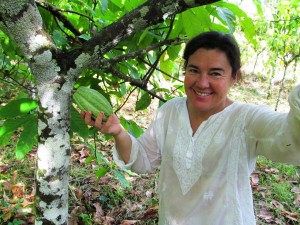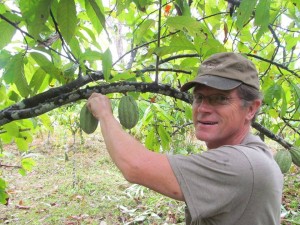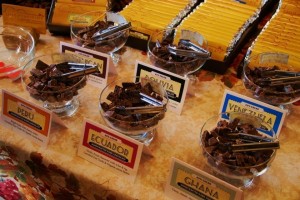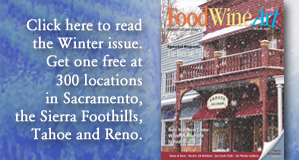From bean to bar: Cello Chocolate visits “the source” in Belize
 LAST NOVEMBER NED & DEBI RUSSELL, owners of Cello Chocolate in Nevada City, spent two weeks living with a Mayan family in San Felipe, Belize, experiencing how cacao is grown at its source—a longtime dream of the artisan chocolate makers.
LAST NOVEMBER NED & DEBI RUSSELL, owners of Cello Chocolate in Nevada City, spent two weeks living with a Mayan family in San Felipe, Belize, experiencing how cacao is grown at its source—a longtime dream of the artisan chocolate makers.
As their hosts, Juan and Abelina Cho of Ixcacao, the only Mayan chocolate maker in Belize, explained, “Because cacao thrives under a canopy of taller trees, it can be planted to co-exist with the large indigenous trees. This allows local farmers to make a living without destroying their native forest.”
The highlight of the Russell’s volunteer experience was joining in the process of converting the cacao bean, which Mayans traditionally have grown, into chocolate bars.
For thousands of years Mayans have used cacao to prepare a sacred beverage, but only recently have they converted cacao into chocolate bars. This empowers local farmers to raise their standard of living.
“We had always vowed that one day we would travel to the source,” Debi said. Cello Chocolate will continue to support small family farmers by making the best chocolate possible with Fair Trade and organic beans.
Following, are some excerpts from Debi’s blog about their adventure.
Total Immersion
Everything this family makes comes from the land. Everything. You want sugar, you grow it and press it. Oh yes, the chicken too came from the farm. I was spared from cleaning and plucking it today, but Abelina told me I would definitely be helping out with that later on.
 Chocolate Will Save Rainforests
Chocolate Will Save Rainforests
This afternoon Ned and I worked in the chocolate lab, packaging more cocoa powder, and then Juan took us to one of his “farms.” Juan has purchased three different plots of land in the rainforest over many years.
Juan is passionate about saving the rainforest and creating a sustainable environment incorporating traditional Mayan ways. He learned it from his grandfather.
We went to the newest farm, and it was an education. Within the past three months, Juan has planted about 300 cacao trees .
What I saw was a thick, humid jungle full of thousands of green plants. As we walked, Juan kept up a running commentary pointing to this and that saying, “This is a poisonwood tree: not good for humans, but it provides nectar for butterflies and birds. This is a cockspur tree, good for treating snake bites.”
He also showed us different animal tracks, such as jaguar and tapir. We also heard the howling monkeys and saw the most amazing butterflies.
We were there to help him put the leftover cocoa shells around the newly planted cacao trees and place germinated coconuts for growing.
King of Mountains
The next day we went to Juan’s most mature “farm” and we saw his cacao trees that were ready to be harvested. It’s about 60 acres and has been in Abelina’s family for many generations. This is the place where Abelina was raised and her parents still live.
Juan began the tour by handing both of us a machete and then taking us on a hike to show us his mature cacao trees. I have to admit I got a bit choked up and teary eyed. All of a sudden it really hit me. I’m on ancient Mayan land among all these gorgeous cacao trees that have been lovingly revered and respected.
Every time Ned and I make chocolate we are always amazed that from these hardshell beans comes this glorious elixir.
For more information, visit CelloChocolate.com
 Where To Buy
Where To Buy
Cello Chocolate can be purchased online at Cello Chocolate.com, or it can be purchased at places including Briar Patch Co-op, Carolines Coffee Roasters and Summer Thyme’s Bakery & Deli, all in Grass Valley; or at Harmony Ridge Market or ol’ Republic Brewery in Nevada City.
(photos: Karl Lanquist and Ned and Debi Russell)
